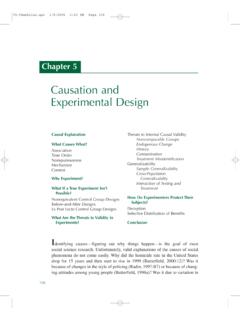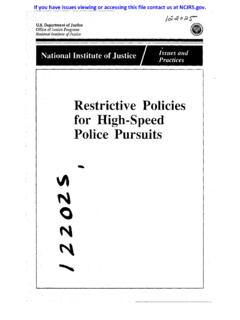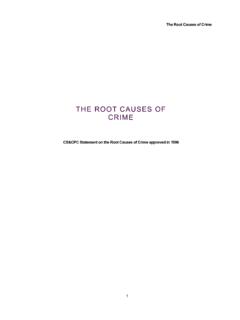Transcription of A School Counselor’s Guide to Reporting Child Abuse ... - ed
1 1 A School Counselor s Guide to Reporting Child Abuse and Neglect April Sikes Old Dominion University A School Counselor s Guide 2 Abstract The process of Reporting Abuse can be challenging, traumatic, and at times, overwhelming. In order for School counselors to be effective helpers for children, it is essential that they know how to recognize and prevent Child Abuse and neglect. The purpose of this article is to provide professional School counselors with information they can use to assist in the identification, Reporting , and prevention of Child Abuse and neglect. A School Counselor s Guide 3 A School Counselor s Guide to Reporting Child Abuse and Neglect Based on statistics gathered through National Child Abuse and Neglect Data System (NCANDS) of the Children s Bureau, for Federal Fiscal Year (FFY) 2005, an estimated 899,000 children in the District of Columbia, Puerto Rico, and the 50 States were determined to be victims of neglect and Abuse ( Department of Health of Human Services, Administration on Children, Youth and Families, 2007).
2 Currently, professionals including counselors, teachers, physicians, and mental health providers are required to report cases of suspected Child Abuse and neglect (Yell, 1996). Since 2001, there has been an increase in the number of children who received an investigation, from an estimated 3,136,000 in 2001 to an estimation of 3,598,000 in 2005. Of those children that received an investigation, approximately one-quarter were determined to have been neglected or abused. According to national reports, of children experienced neglect, were physically abused, were sexually abused, and were emotionally maltreated during FFY 2005. A nationally estimated 1,460 children died of neglect or Abuse a rate of children per 100,000 in the national population for FFY 2005 ( Department of Health of Human Services, Administration on Children, Youth and Families, 2007).
3 For FFY 2005, of Child Abuse victims were girls and of victims were boys. Out of the age groups, the youngest children had the highest victimization ( Department of Health of Human Services, Administration on Children, Youth and Families, 2007). From birth to the age 3, the rate of victimization was higher than any other age group. NCANDS data for 2004 demonstrate that 45% of fatalities were for A School Counselor s 4 children younger than age 1. Children younger than age 4 accounted for 81% of Abuse -related fatalities ( Child Welfare Information Gateway, 2006). A perpetrator of Child maltreatment may be anyone from a mother, father, brother, uncle, aunt, neighbor, or stranger. He or she may choose to act alone or with another individual. For FFY 2005, mothers acting alone maltreated approximately 40% of Child victims, fathers alone maltreated , and both parents maltreated of Child victims.
4 Child victims abused by perpetrators that were caregivers, but not the parents, accounted for ( Department of Health of Human Services, Administration on Children, Youth and Families, 2007). Given these alarming statistics, School counselors are constantly faced with the issue of Child Abuse and neglect. Maltreated children may suffer psychological, emotional, or physical harm as a result of the Abuse , with long and short-term consequences. Some of these consequences include decreased academic performance (Eckenrode, J., Laird, M., & Doris, J., 1993; English, 1988; Yanowitz, K. L., Monte, E., & Tribble, J. R., 2003) aggressive or violent behavior (Eckenrode et al., 1993; English, 1988), decreased self-esteem (Yanowitz et al., 2003), and mental health problems including depression, suicidality, eating disorders, sleep disruption, substance Abuse , and sexual problems (Einbender & Friedrich, 1989; English, 1988).
5 School counselors are not only responsible for Reporting suspected Child Abuse ; they also provide counseling services to children and their parents or guardians, coordinate resources in the community, and design prevention programs (Kenny & McEachern, 2002). In order for School counselors to be effective helpers for children, it is essential that they know how to recognize and prevent Child Abuse and neglect. The A School Counselor s 5 purpose of this article is to provide professional School counselors with information they can use to assist in the identification, Reporting , and prevention of Child Abuse and neglect. This article will address the following topics: (a) recognizing the four main types of Child Abuse or maltreatment, (b) Reporting Child Abuse and neglect, (c) the role of School counselors before and after making a suspected Child Abuse report, and (d) preventing Child Abuse .
6 Recognizing Child Abuse Definitions of Child Maltreatment In an effort to increase the identification, Reporting , and prevention of Child maltreatment, Congress passed the Child Abuse Prevention and Treatment Act (CAPTA) of 1974, Public Law 93-247 (English, 1998). The act established a definition that was to be used nationally and on a state level. In accordance with this law, states are required to take action in protecting children. Four recognized types of Child maltreatment include physical Abuse , neglect, sexual Abuse , and emotional Abuse . According to English (1998), the four types are defined as the following: Physical Abuse : An act of commission by a caregiver that results or is likely to result in physical harm, including death of a Child . Examples of physical Abuse acts include kicking, biting, shaking, stabbing, or punching of a Child . Spanking a Child is usually considered a disciplinary action, although it can be classified as abusive if the Child is bruised or injured.
7 Sexual Abuse : An act of commission, including intrusion or penetration, molestation with genital contact, or other forms of sexual acts in which children are used to provide sexual gratification for the perpetrator. This A School Counselor s 6 type of Abuse also includes acts such as sexual exploitation and Child pornography. Neglect: An act of omission by a parent or caregiver that involves refusal or delay in providing health care; failure to provide basic needs such as food, clothing, shelter, affection, and attention; inadequate supervision; or abandonment. This failure to act holds true for both physical and emotional neglect. Emotional Abuse : An act of commission or omission that includes rejecting, isolating, terrorizing, ignoring, or corrupting a Child . Examples of emotional Abuse are confinement; verbal Abuse ; withholding sleep, food, or shelter; exposing a Child to domestic violence; allowing a Child to engage in substance Abuse or criminal activity; refusing to provide psychological care; and other inattention that results in harm or potential harm to a Child .
8 An important component of emotional or psychological Abuse is that it must be sustained and repetitive. (p. 41) Although each state recognizes Child Abuse and neglect, the definitions may vary from state to state. Section - 100 of the Code of Virginia defines an abused or neglected Child as any Child under 18 years of age whose parent, guardian, or other person responsible for the Child s care: (a) causes or threatens to cause a non-accidental physical or mental injury, (b) neglects or refuses to provide adequate food, clothing, shelter, emotional nurturing, or health care, (c) abandons the Child , (d) fails to provide adequate supervision, or (e) commits or allows to be committed any illegal sexual act upon A School Counselor s 7 a Child including incest, rape, fondling, indecent exposure, prostitution, or allows a Child to be used in any sexually explicit visual material.
9 Behavioral and Physical Indicators The United States Government Printing Office published a document presenting the physical and behavioral indicators of Child Abuse and neglect (Wilder, 1991). Physical indicators of physical Abuse included bruises and welts on the face, mouth, lips, back, buttocks, and thighs. The bruises may be clustered, reflecting the shape of an article used to inflict pain such as a belt strap, belt buckle, or electrical cord, and on several different areas of the body. It is not uncommon for bruises to appear after a holiday, weekend, or absence. According to The National Children s Advocacy Center (2007), physical indicators of physical Abuse include unexplained bruises, burns, and fractures. Areas that are swollen or cut are also physical indicators of physical Abuse . Behavioral indicators of physical Abuse include withdrawing from others, aggressive behaviors, wearing clothing that is inappropriate to weather and body size, complaining of discomfort or pain, arriving early to School and leaves late, and being cautious of adult interaction.
10 Although the presence of these indicators may exist, it does not imply physical Abuse . Children and adolescents, especially males, are playful and aggressive by nature. For many of them injuries, including cuts and bruises, are a common part of play. Unlike physical Abuse , sexual Abuse is difficult to recognize. According to Cole (1995), symptoms are not as clear as with other forms of Child Abuse . The behaviors exhibited by a sexually abused Child may be the same as behaviors exhibited by a sexually developing Child . Physical indicators of sexual Abuse include pregnancy, A School Counselor s 8 difficulty sitting or walking, bleeding or bruises in the genital area, bloody, torn or stained undergarments, and itching, discomfort, or pain in the genital area (Wilder, 1991). James and Burch (1999) classified emotional and behavioral symptoms as externalizing and internalizing.












